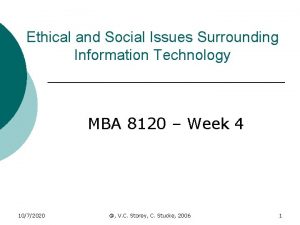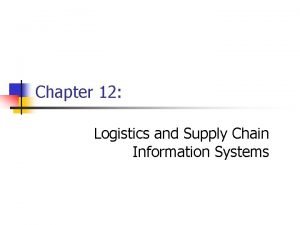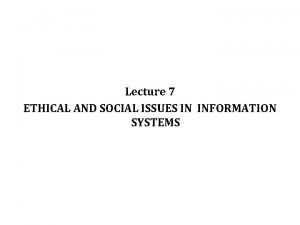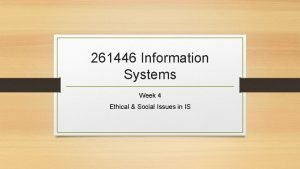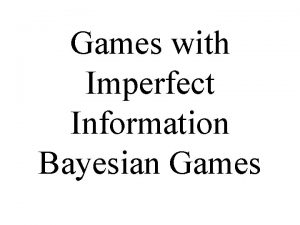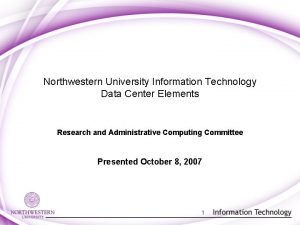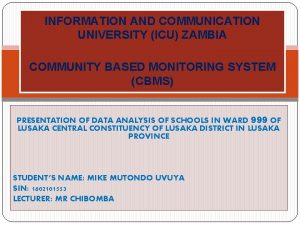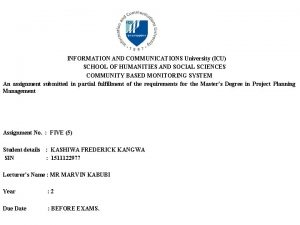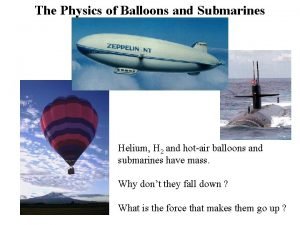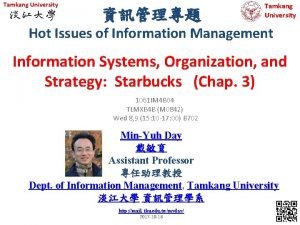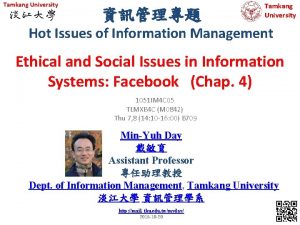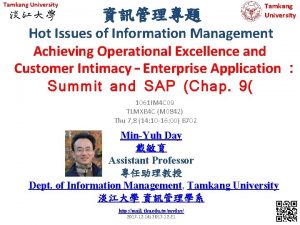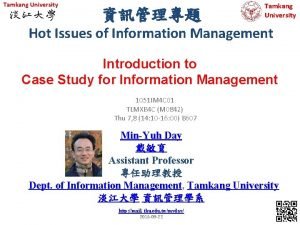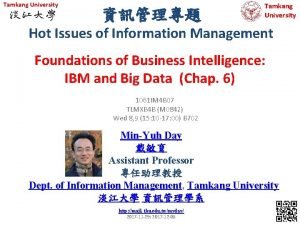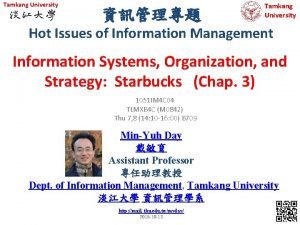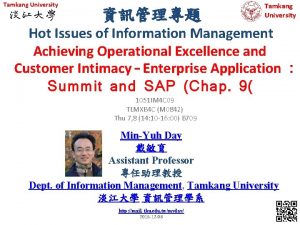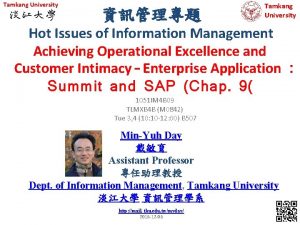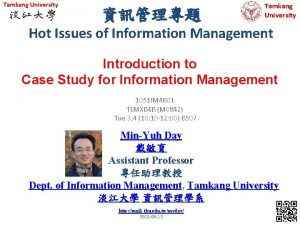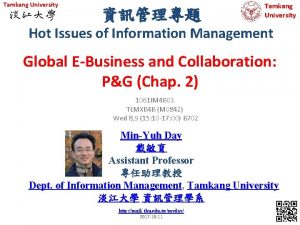Tamkang University Tamkang University Hot Issues of Information









































- Slides: 41

Tamkang University 資訊管理專題 Tamkang University Hot Issues of Information Management Enhancing Decision Making: Zynga (Chap. 12) 1051 IM 4 C 11 TLMXB 4 C (M 0842) Thu 7, 8 (14: 10 -16: 00) B 709 Min-Yuh Day 戴敏育 Assistant Professor 專任助理教授 Dept. of Information Management, Tamkang University 淡江大學 資訊管理學系 http: //mail. tku. edu. tw/myday/ 2016 -12 -22 1

課程大綱 (Syllabus) 週次 (Week) 日期 (Date) 內容 (Subject/Topics) 1 2016/09/15 中秋節 (放假一天) (Mid-Autumn Festival)(Day off) 2 2016/09/22 Introduction to Case Study for Information Management Hot Topics 3 2016/09/29 Information Systems in Global Business: UPS (Chap. 1) (pp. 53 -54) 4 2016/10/06 Information Systems in Global Business: UPS (Chap. 1) (pp. 53 -54) 5 2016/10/13 Global E-Business and Collaboration: P&G (Chap. 2) (pp. 84 -85) 6 2016/10/20 Information Systems, Organization, and Strategy: Starbucks (Chap. 3) (pp. 129 -130) 2

課程大綱 (Syllabus) 週次 (Week) 日期 (Date) 內容 (Subject/Topics) 7 2016/10/27 Ethical and Social Issues in Information Systems: Facebook (Chap. 4) (pp. 188 -190) 8 2016/11/03 IT Infrastructure and Emerging Technologies: Amazon and Cloud Computing (Chap. 5) (pp. 234236) 9 2016/11/10 Foundations of Business Intelligence: IBM and Big Data (Chap. 6) (pp. 261 -262) 10 2016/11/17 期中考試週 11 2016/11/24 Midterm Report (期中報告) 12 2016/12/01 Telecommunications, the Internet, and Wireless Technology: Google, Apple, and Microsoft (Chap. 7) (pp. 318 -320) 3

課程大綱 (Syllabus) 週次 日期 內容(Subject/Topics) 13 2016/12/08 Enterprise Applications: Summit and SAP (Chap. 9) (pp. 396 -398) 14 2016/12/15 E-commerce: Zagat (Chap. 10) (pp. 443 -445) 15 2016/12/22 Enhancing Decision Making: Zynga (Chap. 12) (pp. 512 -514) 16 2016/12/29 Final Report I (期末報告 I) 17 2017/01/05 Final Report II (期末報告 II) 18 2017/01/12 期末考試週 4

Management Information Systems: Managing the Digital Firm 1 2 3 4 Organization, Management, and the Networked Enterprise Information Technology Infrastructure Key System Applications for the Digital Age Building and Managing Systems Source: Kenneth C. Laudon & Jane P. Laudon (2014), Management Information Systems: Managing the Digital Firm, Thirteenth Edition, Pearson. 5

Chap. 12 Enhancing Decision Making: Zynga 6

Case Study: Enhancing Decision Making: Zynga (Chap. 12) (pp. 512 -514) Zynga Wins with Business Intelligence 1. It has been said that Zynga is “an analytics company masquerading as a games company. ” Discuss the implications of this statement. 2. What role does business intelligence play in Zynga’s business model? 3. Give examples of three kinds of decisions supported by business intelligence at Zynga. 4. How much of a competitive advantage does business intelligence provide for Zynga? Explain. 5. What problems can business intelligence solve for Zynga? What problems can't it solve? Source: Kenneth C. Laudon & Jane P. Laudon (2014), Management Information Systems: Managing the Digital Firm, Thirteenth Edition, Pearson. 7

Overview of Fundamental MIS Concepts Business Challenges Management Organization Information System Business Solutions Technology Source: Kenneth C. Laudon & Jane P. Laudon (2014), Management Information Systems: Managing the Digital Firm, Thirteenth Edition, Pearson. 8

Decision Making and Information Systems • Business value of improved decision making – Improving hundreds of thousands of “small” decisions adds up to large annual value for the business Source: Kenneth C. Laudon & Jane P. Laudon (2014), Management Information Systems: Managing the Digital Firm, Thirteenth Edition, Pearson. 9

Types of Decisions • Unstructured: – Decision maker must provide judgment, evaluation, and insight to solve problem • Structured: – Repetitive and routine; involve definite procedure for handling so they do not have to be treated each time as new • Semistructured: – Only part of problem has clear-cut answer provided by accepted procedure Source: Kenneth C. Laudon & Jane P. Laudon (2014), Management Information Systems: Managing the Digital Firm, Thirteenth Edition, Pearson. 10

Information Requirements of Key Decision-making Groups in a Firm Source: Kenneth C. Laudon & Jane P. Laudon (2014), Management Information Systems: Managing the Digital Firm, Thirteenth Edition, Pearson. 11

The Four Stages of the Decision-making Process 1. Intelligence – Discovering, identifying, and understanding the problems occurring in the organization 2. Design – Identifying and exploring solutions to the problem 3. Choice – Choosing among solution alternatives 4. Implementation – Making chosen alternative work and continuing to monitor how well solution is working Source: Kenneth C. Laudon & Jane P. Laudon (2014), Management Information Systems: Managing the Digital Firm, Thirteenth Edition, Pearson. 12

4 Stages in Decision Making Source: Kenneth C. Laudon & Jane P. Laudon (2014), Management Information Systems: Managing the Digital Firm, Thirteenth Edition, Pearson. 13

Decision Making and Information Systems • Information systems can only assist in some of the roles played by managers Source: Kenneth C. Laudon & Jane P. Laudon (2014), Management Information Systems: Managing the Digital Firm, Thirteenth Edition, Pearson. 14

Classical Model of Management: 5 Functions 1. 2. 3. 4. 5. Planning Organizing Coordinating Deciding Controlling Source: Kenneth C. Laudon & Jane P. Laudon (2014), Management Information Systems: Managing the Digital Firm, Thirteenth Edition, Pearson. 15

More Contemporary Behavioral Models • Actual behavior of managers appears to be less systematic, more informal, less reflective, more reactive, and less well organized than in classical model Source: Kenneth C. Laudon & Jane P. Laudon (2014), Management Information Systems: Managing the Digital Firm, Thirteenth Edition, Pearson. 16

Mintzberg’s 10 Managerial Roles • Interpersonal roles 1. Figurehead 2. Leader 3. Liaison • Informational roles 4. Nerve center 5. Disseminator 6. Spokesperson • Decisional roles 7. Entrepreneur 8. Disturbance handler 9. Resource allocator 10. Negotiator Source: Kenneth C. Laudon & Jane P. Laudon (2014), Management Information Systems: Managing the Digital Firm, Thirteenth Edition, Pearson. 17

Three main reasons why investments in information technology do not always produce positive results 1. Information quality – High-quality decisions require high-quality information 2. Management filters – Managers have selective attention and have variety of biases that reject information that does not conform to prior conceptions 3. Organizational inertia and politics – Strong forces within organizations resist making decisions calling for major change Source: Kenneth C. Laudon & Jane P. Laudon (2014), Management Information Systems: Managing the Digital Firm, Thirteenth Edition, Pearson. 18

High-velocity automated decision making • Made possible through computer algorithms precisely defining steps for a highly structured decision • Humans taken out of decision • For example: High-speed computer trading programs – Trades executed in 30 milliseconds – Responsible for “Flash Crash” of 2010 • Require safeguards to ensure properation and regulation Source: Kenneth C. Laudon & Jane P. Laudon (2014), Management Information Systems: Managing the Digital Firm, Thirteenth Edition, Pearson. 19

Business Intelligence (BI) in Enterprise • Business Intelligence – Infrastructure for collecting, storing, analyzing data produced by business – Databases, data warehouses, data marts • Business Analytics – Tools and techniques for analyzing data – OLAP, statistics, models, data mining • Business Intelligence Vendors – Create business intelligence and analytics purchased by firms Source: Kenneth C. Laudon & Jane P. Laudon (2014), Management Information Systems: Managing the Digital Firm, Thirteenth Edition, Pearson. 20

Business Intelligence and Analytics for Decision Support Source: Kenneth C. Laudon & Jane P. Laudon (2014), Management Information Systems: Managing the Digital Firm, Thirteenth Edition, Pearson. 21

Six Elements in the Business Intelligence Environment 1. 2. 3. 4. 5. 6. Data from the business environment Business intelligence infrastructure Business analytics toolset Managerial users and methods Delivery platform—MIS, DSS, ESS User interface Source: Kenneth C. Laudon & Jane P. Laudon (2014), Management Information Systems: Managing the Digital Firm, Thirteenth Edition, Pearson. 22

Business Intelligence and Analytics Capabilities • Goal is to deliver accurate real-time information to decision-makers • Main functionalities of BI systems 1. 2. 3. 4. 5. 6. Production reports Parameterized reports Dashboards/scorecards Ad hoc query/search/report creation Drill down Forecasts, scenarios, models Source: Kenneth C. Laudon & Jane P. Laudon (2014), Management Information Systems: Managing the Digital Firm, Thirteenth Edition, Pearson. 23

Business Intelligence Users • 80% are casual users relying on production reports • Senior executives – Use monitoring functionalities • Middle managers and analysts – Ad-hoc analysis • Operational employees – Prepackaged reports – E. g. sales forecasts, customer satisfaction, loyalty and attrition, supply chain backlog, employee productivity Source: Kenneth C. Laudon & Jane P. Laudon (2014), Management Information Systems: Managing the Digital Firm, Thirteenth Edition, Pearson. 24

Business Intelligence Users Source: Kenneth C. Laudon & Jane P. Laudon (2014), Management Information Systems: Managing the Digital Firm, Thirteenth Edition, Pearson. 25

Examples of BI applications • Predictive analytics – Use patterns in data to predict future behavior – E. g. Credit card companies use predictive analytics to determine customers at risk for leaving • Data visualization – Help users see patterns and relationships that would be difficult to see in text lists • Geographic information systems (GIS) – Ties location-related data to maps Source: Kenneth C. Laudon & Jane P. Laudon (2014), Management Information Systems: Managing the Digital Firm, Thirteenth Edition, Pearson. 26

Predictive Analytics • Use variety of data, techniques to predict future trends and behavior patterns – Statistical analysis – Data mining – Historical data – Assumptions • Incorporated into numerous BI applications for sales, marketing, finance, fraud detection, health care – Credit scoring – Predicting responses to direct marketing campaigns Source: Kenneth C. Laudon & Jane P. Laudon (2014), Management Information Systems: Managing the Digital Firm, Thirteenth Edition, Pearson. 27

Big Data Analytics • Big data: Massive datasets collected from social media, online and in-store customer data, and so on • Help create real-time, personalized shopping experiences for major online retailers • Hunch. com, used by e. Bay – Customized recommendations – Database includes purchase data, social networks – Taste graphs map users with product affinities Source: Kenneth C. Laudon & Jane P. Laudon (2014), Management Information Systems: Managing the Digital Firm, Thirteenth Edition, Pearson. 28

Data Visualization and Visual Analytics Tools • Help users see patterns and relationships that would be difficult to see in text lists – Rich graphs, charts – Dashboards – Maps Source: Kenneth C. Laudon & Jane P. Laudon (2014), Management Information Systems: Managing the Digital Firm, Thirteenth Edition, Pearson. 29

Two Main Management Strategies for Developing BI and BA Capabilities 1. One-stop integrated solution – Hardware firms sell software that run optimally on their hardware – Makes firm dependent on single vendor— switching costs 2. Multiple best-of-breed solution – Greater flexibility and independence – Potential difficulties in integration – Must deal with multiple vendors Source: Kenneth C. Laudon & Jane P. Laudon (2014), Management Information Systems: Managing the Digital Firm, Thirteenth Edition, Pearson. 30

Business Intelligence Constituencies • Operational and middle managers – Use MIS (running data from TPS) for: • Routine production reports • Exception reports • “Super user” and Business Analysts – Use DSS for: • More sophisticated analysis and custom reports • Semistructured decisions Source: Kenneth C. Laudon & Jane P. Laudon (2014), Management Information Systems: Managing the Digital Firm, Thirteenth Edition, Pearson. 31

Decision Support Systems • Use mathematical or analytical models • Allow varied types of analysis – “What-if” analysis – Sensitivity analysis – Backward sensitivity analysis – Multidimensional analysis / OLAP • For example: pivot tables Source: Kenneth C. Laudon & Jane P. Laudon (2014), Management Information Systems: Managing the Digital Firm, Thirteenth Edition, Pearson. 32

Sensitivity Analysis Source: Kenneth C. Laudon & Jane P. Laudon (2014), Management Information Systems: Managing the Digital Firm, Thirteenth Edition, Pearson. 33

A Pivot Table that Examines Customer Regional Distribution and Advertising Source: Kenneth C. Laudon & Jane P. Laudon (2014), Management Information Systems: Managing the Digital Firm, Thirteenth Edition, Pearson. 34

ESS: Decision-support for senior management • Help executives focus on important performance information • Balanced scorecard method: – Measures outcomes on four dimensions: 1. Financial 2. Business process 3. Customer 4. Learning & growth – Key performance indicators (KPIs) measure each dimension Source: Kenneth C. Laudon & Jane P. Laudon (2014), Management Information Systems: Managing the Digital Firm, Thirteenth Edition, Pearson. 35

The Balanced Scorecard Framework Source: Kenneth C. Laudon & Jane P. Laudon (2014), Management Information Systems: Managing the Digital Firm, Thirteenth Edition, Pearson. 36

Decision-support for Senior Management • Business performance management (BPM) – Translates firm’s strategies (e. g. differentiation, low-cost producer, scope of operation) into operational targets – KPIs developed to measure progress towards targets • Data for ESS – Internal data from enterprise applications – External data such as financial market databases – Drill-down capabilities Source: Kenneth C. Laudon & Jane P. Laudon (2014), Management Information Systems: Managing the Digital Firm, Thirteenth Edition, Pearson. 37

Group Decision Support Systems (GDSS) • Interactive system to facilitate solution of unstructured problems by group • Specialized hardware and software; typically used in conference rooms – Overhead projectors, display screens – Software to collect, rank, edit participant ideas and responses – May require facilitator and staff • Enables increasing meeting size and increasing productivity • Promotes collaborative atmosphere, anonymity • Uses structured methods to organize and evaluate ideas Source: Kenneth C. Laudon & Jane P. Laudon (2014), Management Information Systems: Managing the Digital Firm, Thirteenth Edition, Pearson. 38



References – Kenneth C. Laudon & Jane P. Laudon (2014), Management Information Systems: Managing the Digital Firm, Thirteenth Edition, Pearson. – Kenneth C. Laudon & Jane P. Laudon原著, 游張松 主編,陳文生 翻譯 (2014), 資訊管理系統,第 13版,滄海 41
 White hot vs red hot temperature
White hot vs red hot temperature Hot principle
Hot principle Perbedaan hot lava dan hot lava volcano
Perbedaan hot lava dan hot lava volcano Hot nor
Hot nor Professional issues in cyber security
Professional issues in cyber security Issues surrounding information privacy
Issues surrounding information privacy Issues in information systems
Issues in information systems Ethical and social issues in information system
Ethical and social issues in information system Legal ethical and societal issues in media and information
Legal ethical and societal issues in media and information Chapter 4 ethical issues
Chapter 4 ethical issues Contemporary issues in information systems
Contemporary issues in information systems Information about social issues
Information about social issues Social issues in technology management
Social issues in technology management Legal and ethical issues in information security
Legal and ethical issues in information security Chapter 4 ethical and social issues in information systems
Chapter 4 ethical and social issues in information systems Ethical and social issues in information systems
Ethical and social issues in information systems Imperfect vs incomplete information game
Imperfect vs incomplete information game Northwestern mailroom
Northwestern mailroom Information and communications university zambia
Information and communications university zambia Tashkent university of information technology
Tashkent university of information technology Department of information engineering university of padova
Department of information engineering university of padova Information engineering padova
Information engineering padova Information and communications university
Information and communications university Pace university information technology
Pace university information technology 沈榮麟
沈榮麟 Hot pack kontrendikasyonları
Hot pack kontrendikasyonları Hot.xxxxx
Hot.xxxxx Hot air oven easy diagram
Hot air oven easy diagram Why is las vegas so hot
Why is las vegas so hot Hamburger sandwich fillings and spread
Hamburger sandwich fillings and spread Osha hot work
Osha hot work Soaker visbreaking
Soaker visbreaking Erdes hot
Erdes hot What keeps the sun hot
What keeps the sun hot Physics of hot air balloons
Physics of hot air balloons On a hot summer day
On a hot summer day Message hot oil
Message hot oil In the japanese game show sushi roulette
In the japanese game show sushi roulette Solar hot dog cooker
Solar hot dog cooker Brianna jordan hot
Brianna jordan hot Is the sun a star
Is the sun a star As hot as simile
As hot as simile





